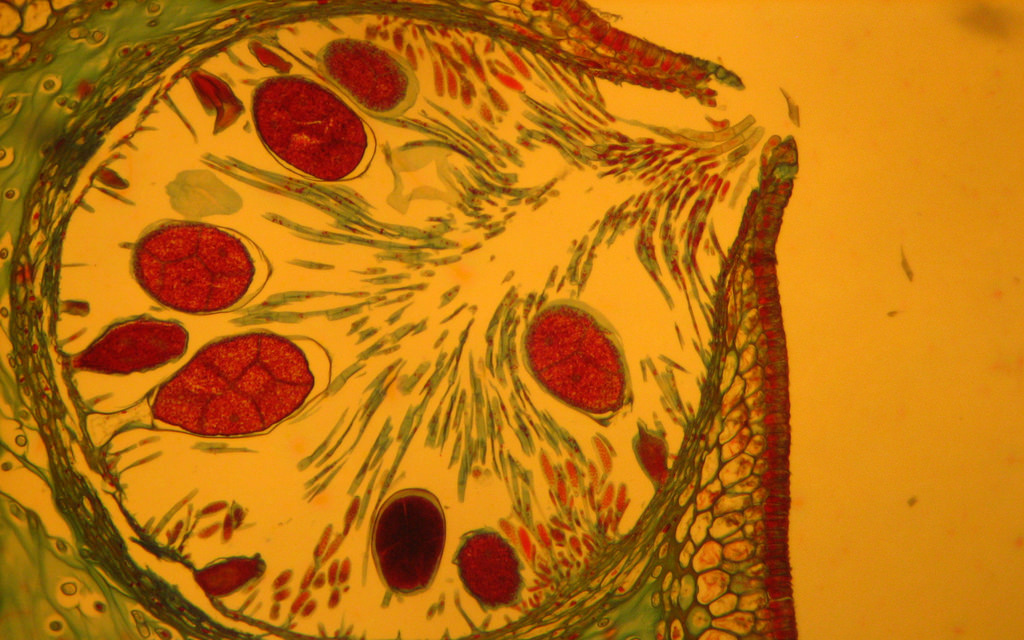Biology: A Tree of Eukaryotes
Catharina Coenen
Listen to A Tree of the Eukaryotes:
I spend my days teaching about strangers: blobs of slime, walkers on legs that aren’t legs, seers with eyes that aren’t eyes. Most days I walk through biology in the dark, my hands outstretched, calling to those who walk behind me, holding on to the hem of my shirt: “Watch out, there’s a bump here,” “give me your hand: feel how smooth this is,” “taste this,” “now: duck.”
Teaching equals storytelling about shadows on the wall; the slide projector, my bonfire in Plato’s cave. Most days it feels like singing in the dark.
The tree of the eukaryotes was like that. For decades, I taught about forks in the road of evolution of the nucleated cells: left to the fungi, right to the animals. Remember, we lost the plants way back, one point five billion years ago, though by then we had stuck it out together, through hell and high water, for a half a billion years. And, oh yes, finally, don’t forget to look over there, far off to the left: see that big bag full of beings we don’t know what to do with? The amoebae, protozoans, flagellates? The algae, water molds, and parameciums? We call them protists. And then we usually just leave them there, rattling around together, like the scissors, string, and thumbtacks; the postcard from Aunt Mary we never got around to answering; the wine bottle corks we always meant to make into something else, the potholders and the shipping tape. That most important drawer in our kitchen where we keep things joined only by our inability to figure out where they belong.
But then: someone cared enough! Many people did. For decades, they deep-read the DNA. They scratched their heads. They sorted. They debated. They tried again. And then they said: “This isn’t quite right, and yes, we’re going to mess with this some more, and probably we’ll keep on messing for many years to come. We never may be done. But meanwhile: here’s a map.”
A map of sorts. Not like the maps of yore, with large white swaths—here be dragons—but one with way too many names and lines. Like barcodes bristling out in all directions, forming a frightened porcupine. Like the world’s most complicated game of pick-up sticks. The tree, the river delta, the forks in the road, had burst into a sun, a wild wheel, orange, yellow, red. A solar explosion, with many roads erupting from the center all at once.
Well, you know, we just don’t know. Right here, at the heart of things? Is mystery. Yes, we know there ought to be a single root, but for right now, life’s not a tree and not a bush—it is a tumbleweed.
Thank you, I sighed. For being honest. Thank you for the fierce orange glow.
The slime molds had come home, snuggling up against fungi and animals, asking “will you be my neighbor?” The amoebae, like splattered raw egg white, had fragmented all over everything, crawling along branches far apart. Adoption of chloroplasts by nucleated cells happened not once, but here, and here, and here, leaving hope for the future. (Really, you have never wanted to be green?)
“But, in the end, the point is,” I tell my students, waving my hands, “the point is that, right now, some of the cells that are your blood hunt, blob-like, for bacteria like amoebae crawling through a bog. Along your airways your ciliated cells beat in unison, like a blanket woven from a thousand docile parameciums. Bone precipitates in tiny spaces made by cells pretending to be foraminifers. And they all talk, sing symphonies of molecules, hum melodies of chemistry they picked up in archaeal soup: We’re in this together, sharing wild inventions. Your body came from a flagellate swimming towards an egg’s scent with the same whiplash strokes used by any microscopic alga making a red tide.”
I still lie to my students, all the way through years one and two. I still teach them to count: one—animals, two—fungi, three—plants, four—protists, five—bacteria. A lie of separation, as blatant as it is safe; a rooted story branching towards a familiar present tense. I lull them, so they’ll follow me into the dark. And then I let them hate me when the sun bursts out: I yank the root and watch them flail, initiate them into the tribe of tumbleweeds.
Provenance: Submission
 Catharina Coenen is a plant biologist and first-generation German immigrant to Northwestern Pennsylvania, where she teaches biology at Allegheny College. Her academic research has been published in Plant Physiology, New Phytologist and other plant biology journals. Her creative nonfiction pieces are forthcoming in Appalachian Heritage, Christian Science Monitor, and elsewhere.
Catharina Coenen is a plant biologist and first-generation German immigrant to Northwestern Pennsylvania, where she teaches biology at Allegheny College. Her academic research has been published in Plant Physiology, New Phytologist and other plant biology journals. Her creative nonfiction pieces are forthcoming in Appalachian Heritage, Christian Science Monitor, and elsewhere.
Featured Image: “Fucus” by JJ is licensed under CC BY 2.0
Author Photo by River Branch


Arint conferences
May 16, 2019 at 4:44 amWONDERFUL Post.thanks for share.
lucylkent
November 3, 2019 at 8:55 pmyou said here very well, keep it up!
SherryVLong
November 4, 2019 at 2:19 amyou said here very well i bookmark this page for read later
Esdoll
November 4, 2019 at 10:38 pmAwesome blog! i really enjoyed your article.
neighbourcare
November 27, 2019 at 2:37 amNice post
Nishika Sharma
January 17, 2020 at 12:25 amSuch a great topic for discussion, given so much information on it about eukaryotes. Thanks for sharing.
India Travels
January 17, 2020 at 2:04 amnice
Fiji Tourism
January 17, 2020 at 2:07 amgood
Web App Development
February 18, 2020 at 4:24 amEveryone needs this type of information and gain some knowledge. Thanks for sharing such useful information.
Apni Dukan Apna Vyapar
May 1, 2020 at 1:07 amGreat Information, It helped us a lot.
Pacific Consulting
February 1, 2021 at 1:43 amThanks for sharing this blog with us.
permanent Staffing agencies
NRI Classes
February 3, 2021 at 3:40 amVery informative content and interesting blog post.
beginner flute lessons online Course
Stuti
September 7, 2021 at 2:04 amknowledgeable article, do share more such articles to keep us updated.
Tecsplus
September 9, 2021 at 4:08 amNice Post!! I am looking for this kind of posts from last many days. thanks for share it with us.
sarajay
September 26, 2021 at 4:07 amYou wrote a nice things here for us.
Best Lube Brands
October 7, 2021 at 3:18 amIf you are looking for how to clean silicone then you can read our post on it.